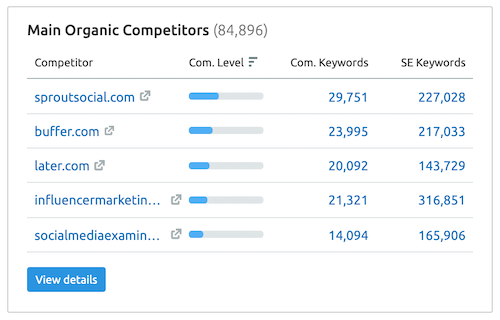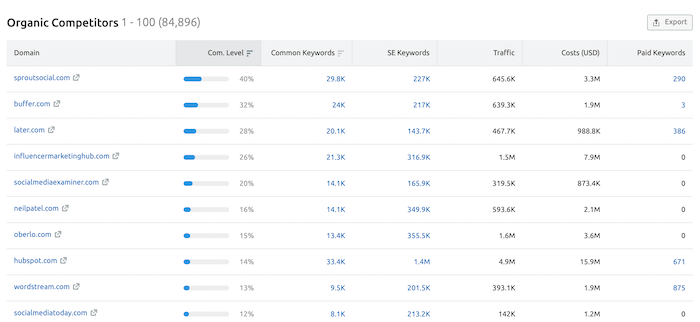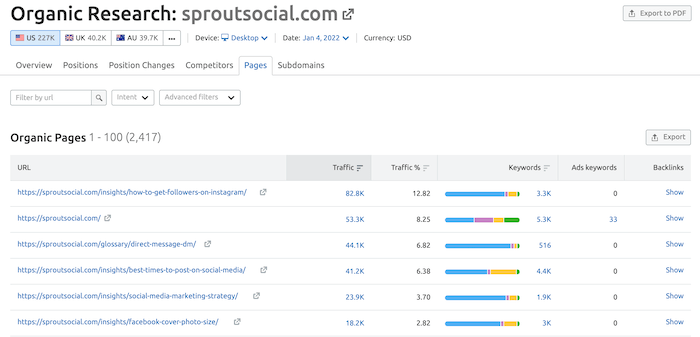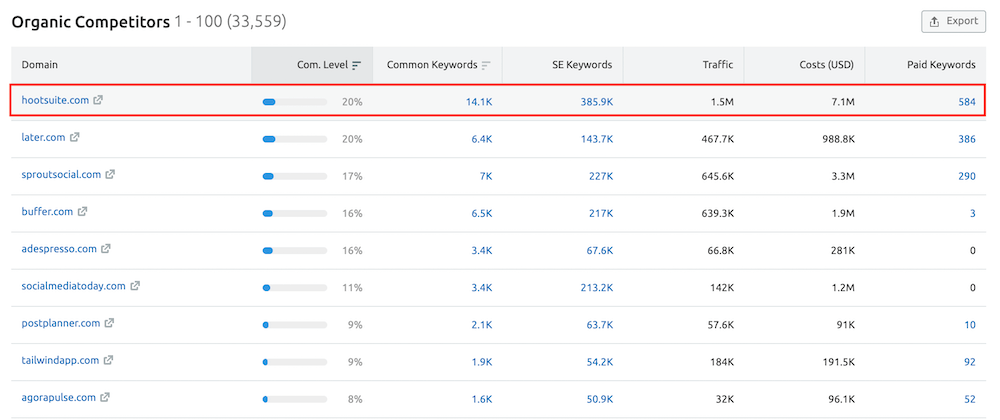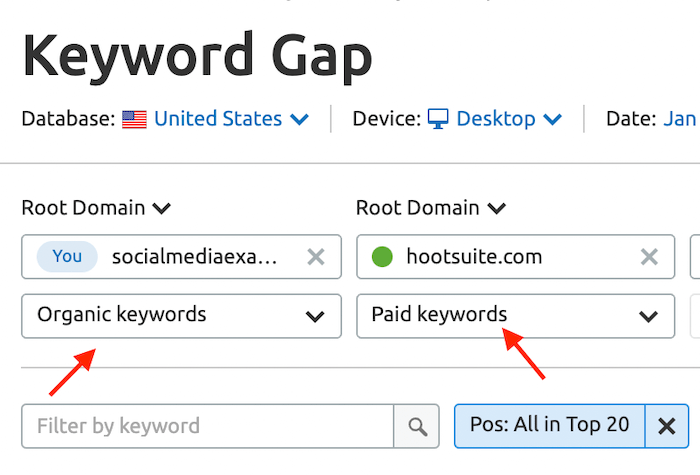Semrush is a must-have tool in your SEO toolkit if you’re serious about increasing organic traffic for your website. What started as a simple keyword research tool is now the preferred online marketing tool of marketing professionals around the world. Semrush is the ultimate SEO tool that helps you get deeper insights into your competition, identifies your top organic keywords as well as paid keywords, allows you to do backlink analysis, and much more. In this article, we’ll examine 6 ways you can use Semrush to instantly improve your site’s SEO and crush your competition. Note: You’ll need an active Semrush account to try the techniques listed in this article. If you don’t have a Semrush account yet, you can sign up for a free 30-day trial of Semrush Pro here (worth $119.95).
6 Ways to Use Semrush to Supercharge Your SEO
1. Identify Your Competitors
One of the key aspects of SEO is to identify the competitors in your niche. It doesn’t matter which industry you belong to, you’ll have plenty of brands to compete with and learn from. To that end, there’s no better tool than Semrush to map your competitors. The only tool that comes close is Ahrefs. Even with Ahrefs, the data obtained can sometimes be inaccurate. Semrush provides you the most accurate data on your competitors so you can start working on your strategy right away. To identify your organic competitors, just enter your domain in the Semrush search box and navigate to the “Main Organic Competitors” column in the overview report. You’ll find your top 5 organic competitors here. These are the domains you’re competing against in Google for the same keywords. The more keywords you share with your competitor, the higher the competition level will be. For example, a quick search on “hootsuite.com” showed these top 5 organic competitors:
It wasn’t surprising to find other top social media schedulers like Sprout Social, Buffer, and Later in the list of top 5 organic competitors for Hootsuite. You’ll also see columns for competition level, common keywords, and the total number keywords the competing site is ranking for in Google’s top 100 search results. To view more competitors, hit the “View details” button below the column. You’ll see a complete list of organic competitors, alongside important SEO metrics.
Click on any of these competitor domains to unravel key data from each site and level up your SEO strategy. Exclusive offer: Get a 30-day free trial to Semrush Pro (worth $119.95)
2. Identify Your Competition’s Top Content
Semrush also allows you to analyze your competition’s top-ranking content. Enter your competitor’s domain in the search bar and then navigate to: Competitive Research > Organic Research Open up the Pages tab to view your competitor’s top-performing content.
This report shows all the pages your competitor has ranking in the top 100 Google search results. Semrush will provide further estimation of the total organic traffic, traffic percentage, the total number of keywords that piece of content is ranking for, and additional data on backlinks and paid keywords. You can export the list of keywords onto a spreadsheet for manual review and sorting. These are all the keyword variations you should use while creating your own content. Make sure these keywords or their variations are part of your on-page SEO elements such as title tags, headings, body copy, image SEO, URL, etc.
3. Identify Your Top Ranking Keywords
Yet another Semrush feature that is incredibly useful. Organic traffic is going to be one of the major drivers of traffic to your website. This feature allows you to review the top-ranking organic keywords for your site and helps you determine whether or not your SEO strategy is working. You can also view your competitors’ top-performing keywords and discover potential content ideas and topics for your site. To view your top ranking keywords, enter your domain in the Semrush search bar and navigate to: Competitive Research > Organic Research Open up the Positions tab and examine the results here.
Don’t just focus on the list of keywords. Pay special attention to the following five columns on the right to determine how each keyword is performing in SERPs:
Search intent Position Volume Keyword difficulty (KD) score Traffic percentage
This will show you how your site is performing on Google and whether or not you need to tweak your organic SEO strategy to focus on a different set of keywords. Learn more: How to Use Semrush for Keyword Research: The Definitive Guide
4. Find News Ways to Monetize Your Website
If you’re a blogger driving decent traffic to your site for certain topics, you’re probably always on a lookout for new ways to monetize your website. There are several sites out there that are willing to pay for the traffic you are driving through organic results. As such, if you’re able to identify these sites and offer them advertising options on your website, you could earn a few extra bucks. Semrush makes this incredibly easy. Here’s how to use Semrush to find new ways to monetize your site:
Enter your domain in the search bar to generate a domain overview report. I’ll be taking the popular social media marketing blog, Social Media Examiner (socialmediaexaminer.com), as an example.
Scroll down to the Main Organic Competitors section and hit “View all” to see the full list of organic competitors.
Check out the Paid Keywords column. For this example, let’s pick Hootsuite (hootsuite.com) since it has 584 paid keywords.
Next, click through the number in the Common Keywords column next to Hootsuite.
This will open up the Keyword Gap tool. In the drop-down menu below each domain, make sure you pick “Organic Keywords” for your domain and “Paid Keywords” for your competitor’s domain.
In the resulting report, scroll down to see the complete list of shared keywords.
As you can see, I have highlighted two specific set of keyword phrases — “automate instagram posts” and “social media marketing podcast”. In both these cases, while Social Media Examiner is currently ranked at #1 organically in organic search results, Hootsuite is bidding for the same keywords on Google Ads to rank at #1 in paid search results. So in order to make full use of this feature, reach out to some of the websites which are bidding on terms you’re ranking for and see if they are interested in placing ads on your site. Negotiate an ad fee and start monetizing the organic traffic on your site. Exclusive offer: Get a 30-day free trial to Semrush Pro (worth $119.95)
5. See the Breakdown of Your Competitors
We already know how Semrush helps us identify our top competitors. You can go a step further by reviewing your competitor breakdown. Why is this important? Because when you do competitor research on Semrush, it produces a report which has hundreds, even thousands of organic competitors. The amount of data at your disposal can be overwhelming. As a result, it’s important to first consider your top 5 or 10 competitors and review their strategies individually.
The report on organic competitors can be filtered by:
Competition Level Common Keywords SE Keywords Traffic Costs (USD) Paid Keywords
With a detailed report from Semrush, you’ll get a deeper understanding of what your competitors are doing, how you’re stacking up against them, and what you can do to improve your ranking in SERPs.
6. Find High-Quality Link Building Opportunities
You can use Semrush to not just review your backlinks, but your competitors’ backlinks as well. To perform backlink analysis on Semrush, enter your competitor’s domain in the search bar and then navigate to: Link Building > Backlink Analytics In the Backlinks Overview report, pay special attention to Referring Domains and Backlinks.
The overview report will also contain useful graphs and widgets on changes in the referring domains and backlinks, new and lost backlinks, categories of referring domains, referring domains by authority score, link attributes (follow, nofollow, etc.), backlink types, and more.
When you click through the Referring Domains number, you’ll get a deeper understanding of your competitor’s link profile. You can then use advanced filtering and sorting options to identify potential link building opportunities.
Once you’ve reviewed your competition’s link profile, use these link building techniques to build new backlinks for your site.
Final Thoughts
Now that you know how to use these features on Semrush, it’s time for you to test drive the product and see the results yourself. If you haven’t used Semrush yet, you can sign up for a free 30-day trial here. If you found this article useful, please share it on Twitter using the link below: Editor’s Note: This article was first published on 23 August 2016 and has been updated regularly since then for relevance, freshness, and comprehensiveness.
Semrush Review: The SEO Tool Trusted by Experts Semrush vs Moz: Which is the Best SEO Tool? How to Use Semrush for Keyword Research: The Definitive Guide 10 Actionable Things You Can Do with Semrush to Boost Your Traffic Semrush vs SpyFu: Which Competitor Analysis Tool is Better?

